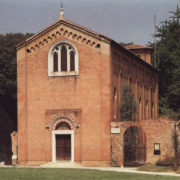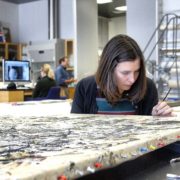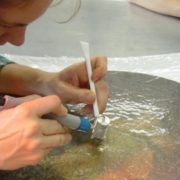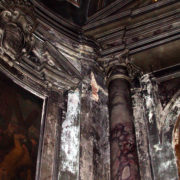Reversibility? “Science”? A Word on Current Restoration Methods
Current restoration materials and practices are not as benign as the practitioners would have us believe.
Our visual heritage is being tampered with daily while the intellectual community has remained silent over the results. I have difficulty comprehending the reluctance with which philosophers, art scholars, historians, writers, filmmakers, novelists and poets have approached or, better, avoided the issues surrounding modern restoration practice.
After all, the number and the extent of restorative interventions has exploded within the walls of world-class museums, illustrious churches and public buildings. No discrimination is discernible in terms of objects’ origins: ancient, modern and everything in-between is proper fodder for the ever expanding, voracious restoration mechanism. Symptomatically, international fairs devoted to restoration are flourishing in many countries, including in the United States and Italy. Universities too have gotten into the act while restoration schools and how-to institutes have cropped up everywhere. Even part-time training is available so that after a matter of months at a nondescript night school, an individual can hang out his or her shingle as a proper restorer. After all, in most countries, no state examinations nor certifying structures are in place for this profession. I recognize, of course, that serious training institutions may be found in many places although even in them, no consensus has been reached about the curriculum for producing graduates. And of course, I realize too that honorable and moral practitioners of the activity abound. However, the overall training component of restoration has grown enormously while the entire enterprise remains totally without oversight. Even the distinction between restoration and conservation has not yet been clarified. Despite such deficiencies, the broader society seems prepared to accept whatever is fed to it regarding restoration issues.
The issues surrounding modern restoration are by no means limited to the heralded pictorial interventions like the Sistine Chapel frescoes or Leonardo’s Last Supper. Much of the ancient, medieval, Renaissance, Baroque and Neo-Classical sculpture, in all materials, has been systematically ‘adjusted’ to meet certain undefined standards but with all-too identifiable effects. Architectural restoration, doubtless a more profitable activity than restoration of painting or sculpture, can be seen at its best (or really at its worst) in today’s Rome where preparations for the Jubilee provide a frightful testimony as to the prevalence of this type of restoration effort.
It may not be an exaggeration to declare that the past in England, France, Germany and Italy, as it has been preserved in its art and architecture, is becoming unrecognizable. All this is not to say that previous epochs have not done their share of damage to beloved buildings and respected art treasures. But we today, being practically into the twenty-first century, think we know better than our predecessors, and are certainly cognizant and often critical of the losses that have occurred in the past. Yet individuals are few and far between who are prepared to plunge into the troubled waters of restoration discourse and question the current situation.
Even art and architectural historians whose very subject matter, whose raw material, whose database, so to speak, is experiencing daily transformation before their eyes have been reticent about engaging in the issue. When they do, they are more often than not unwilling to enter into anything like open debate. This inexcusable avoidance requires explanation and comment, if for no other reason, than to set the record straight. One element of this reluctance must be self-interest. To swim against the high tide of art cleaning, which became a dominant museum activity over the past two decades, results in becoming ostracized from the museum world and its perks. Those blockbuster shows like, the Vermeer, the Lotto, the Matisse or any other, are intimately tied to restoration because of the ugly habit of preparing the works to be exhibited so that they appear in a “refreshed” mode which usually means that they are homogenized with all the others.
The ‘new’ interpretations of one artist or another which results from the blockbuster offers the art historian the opportunity to participate in the resulting symposia and international congresses. The same is true following the restorations of well-known or important works. These too require a whole new apparatus. What art specialist would be willing to forego a role in these activities? This would mean being left out of the massive catalogues that usually accompany art spectaculars. For those who enjoy it, there are also opportunities to participate in television interviews, or appear on any accompanying CD-ROM merchandise. Each of these can involve substantial compensation. To be at odds with the museum community means to forego all of it.
Who is so naive as not to realize that anyone who appears too negative toward the “new” (or to use one of the more popular operative words, “glorious”) appearance of recently cleaned art works is rarely the favorite candidate to write monographs, catalogue introductions or items in prestigious journals? Such opponents are, instead, marginalized. Even their grant-winning capacity can be jeopardized by what is regarded as a hostile position towards modern restorations. This bias is quite similar to the one shown to those who are unsympathetic to the dominant contemporary art styles. Of course there are those specialists who in good conscience regard the interventions as necessary, healthy and even excellent, and believe that they demonstrate scientific progress in restoration activity. My own bias is that these individuals are unable to really “see” works of art. Nevertheless, what is truly confounding about their position is that they are extremely reluctant to engage in serious discussion of the matter. That failure, in my view, basically disqualifies them from being taken seriously on the issue.
Often, it is this same category of individuals who in taking pride and having confidence in their skills and especially in their “eye,” rely solely upon these abilities as proof of the validity of a restoration. Of course, like art itself, the ability or the absence of ability to confront art objects, is always difficult, if not impossible, to quantify. One’s position in the art world is usually taken as proof of such an ability. But a university post, directorship of an institute, a government or museum position should be regarded as license to avoid serious debate on the issues surrounding modern restoration. Regularly, however, they are.
If specialists’ reluctance can be explained as I have suggested, or at least if my proposals can be taken as highly plausible, one is left to speculate as to the reasons preventing the larger intellectual community from taking part in this issue (the matter cannot properly be referred to as a debate because exchanges have been only sporadic and isolated). I am inclined to explain this negligence on the basis of the visual insecurity that pervades our entire culture, even among the elite, especially since the domination of abstract art. If one has serious reservations about, for instance, arte povere or Neo-Dadaism, following such art’s fifty plus year hegemony, it is difficult to say so publicly without sounding like a totally uncultivated and uncivilized reactionary. Thus, the time in which a writer could seriously deal with art seems to have passed. This is most true of discussions of contemporary art but also holds in discussions of older art as well. When combined with the bias of an age that admires (only?) the opinion of the specialist anyway, the temptation is strong for scholars outside the immediate field to remain silent. Who wants to be belittled as being inexpert, poorly prepared or even foolish?
However, such an eventuality is very real, given the overlay of science on modern restoration. When the operatives in the restoration field call upon “science,” humanists tend to tremble and shy away. Of course it is never mentioned that a determining role of science in the process is very questionable in the first place. It is applicable mainly for purposes of diagnosis; as a data supplier. The notion of a scientific repainting is a nonsense. Additionally, what humanists often tend to forget is that scientists differ among themselves all the time so that science in art restoration rarely, if ever, offers a single answer.
Still more to the point in explaining the reluctance of the intellectual community to critically examine questions of modern restoration is a widely diffused crisis in perception which, I fear, also encompasses the very restorers who are at work daily on our treasures, not to mention their supervisors, those high-minded and high powered museum directors, curators and superintendents. After a generation of almost constant bombardment of plastic colors, of back-lit television tubes, of videos, computer screens, signage, magazine illustrations, and more recently those rather dismally colored daily newspapers, our communal vision cannot fail to have been affected. Coupled with a crippled color sensibility, is a diminished orientation toward comprehending sculptural volume. From the Renaissance onward, at least in painting, credit has always been given to those artists who could make the objects they depicted seem as “real” as they appeared in nature. With the art of the past century, since artistic goals began to be replaced by others in which the flatness of the picture plane gained prestige. The perception of earlier art, as it was intended to be perceived, became more difficult. This factor must have compounded the more general visual insecurity mentioned already and, if taken in conjunction with the opinions of restoration-at-any cost proponents, inevitably results in a certain confusion.
–Reversibility–
Reversibility is a touchstone concept for explaining modern restoration practice to the public. Ostensibly it separates old and insidious pictorial interventions from modern, sensitive, responsible and “scientific” ones. Reversibility which serves as a guarantee of safety would assure us that regardless of whatever might have transpired during the restorative process, normally including cleaning, the final appearance of a painting can always be returned to its previous state by the flick of a wet sponge. Any repainting or integration undertaken can be undone because all such applications are executed with water soluble paint. Hence in merely a moment, all the problems of questionable interventions can be safely eliminated, since, we are further assured, any overpainting, is separated from the original by a layer of varnish which serves as the base for the new painting. Thus what is left of the old and original (albeit newly cleaned) surface is effectively insulated from the modern repainting.
This rationale, incidentally, begs the question of the status of the new varnish which has been applied in preparation for the over painting, not to mention the status of the varnish which is always applied to the whole picture as a final step in any restoration. This latter varnish covers everything on a painting’s surface, including the reversible water paints. Varnishes are not water soluble, but require a chemical solvent for removal. Although such an operation may be the harmless exercise that we are told it is, it is also possible that the chemical properties of the solvents will act in unpredictable or unwanted ways. Nevertheless, this is a side issue for the purposes my present discussion.
As the official line of explanation runs, the art object is always safe from irrevocable alternations because of the reversibility of the colors applied. However, is this contention, one which is central for restoration rhetoric if not for actual practice, really true? Or can the notion of reversibility be shown to be anything but reassuring? I shall, in fact, argue that reversibility as a concept should be regarded with deep distrust.
To start, one should recall that reversibility, as an operational approach, is only applicable to the second stage of the normal restorative process: the stage following the repairs and cleaning of the surface. The actions taken during this first stage, are never reversible, since they all involve the process of (permanent) removal of certain material or substances. To be sure there are always choices as to what is to be removed and what is to be kept. That is, the restorer must correctly identify and then contend with dirt, old varnish, old repaints, etc. Following the restorers intervention, anything that has been removed, even if removed in error, cannot, of course, be put back. It would not be a mistake here to clearly and unequivocally state that we have a virtually surreal condition in which an application commonly regarded as a reversible one is superimposed upon an irreversible one.
To further compound the problem, the notion of reversibility has a subtle yet significant impact upon this first stage of cleaning and fixing. It is an effect that is never considered but one that can determine the integrity of the restoration’s final result. The recognition on the part of the restorer that from the very beginning of the intervention process she/he will be able to change the original surface of a picture once the restoration is at the second stage, including even the painting in of lost areas, modifies and can give fatal direction to every step in the restorer’s procedure. In other words, the restorer is fully aware that with the reversibility methodology in place, there is nothing which cannot be “corrected” or unified by means of subsequent in-painting, use of toned varnishes, or the adjustment of light. Consequently, the concept of reversibility affords license and wide latitude in the cleaning operation because the restorer knows full well that later in the process any unfortunate events produced during the first stage of the restoration can be remedied.
The situation can be readily followed by turning to the current, much labored and widely heralded restoration of Leonardo’s Last Supper. This work has suffered devastatingly from aging and endless interventions in the previous centuries and these effects are compounded by the presumed use by da Vinci of an experimental technique which decreased the durability of the painting. Many areas of this painting reveal only tiny islands of original pigment adrift on a pockmarked surface, a condition exaggerated by the current twenty-year campaign which has sought with authoritarian insistence to remove all of the repaints old and new, as well as to make repairs for the avowed purpose of getting at what is regarded as the original Leonardo. This radical action was permissible because the restorer from the very outset knew that she would eventually fill in or at least adjust the losses on the surface with the semi-neutral application of water based colors or with more substantial repaintings and outlining which one can readily see in the heads of certain Apostles and in the head of Christ. These are not true restorations but reconstructions. They are the restorer’s interpretations of what the originals might have looked like.
Obviously, no matter how careful and conscientious the removal of the old repaints has been, the jagged irregularity of the edges of the original bits are altered, even if only slightly. Since there is so little of Leonardo’s paint left on the surface in the first place, the realization that an opportunity will be available later to correct whatever one wishes, has given the restorer courage to remove, for eternity, more than she might have otherwise. We are here dealing with the tangible results of the superimposition of what is rightly or wrongly regarded as a reversible application upon an irreversible one: the restorer can, and here has, moved ahead without trepidation. Everything can be adjusted in the next round.
Not only does this argument apply to wall painting (including both Leonardo’s puzzling a secco technique in addition to standard buon fresco), but pertains to panel and canvas paintings as well, whether executed in oil or in tempera. In these cases, where flaking has occurred the restorer is virtually obliged to adjust the edges of the remaining areas in order to prevent further deterioration, by filling in the missing portions, large or small, and eventually by adjusting and over painting those very same areas with water soluble colors.
However, we must return to the original question: Can the integrations, in painting and repainting really ever be reversible? In those areas, for example, where a new ground has been applied and then painted over with water soluble pigments, several factors must be considered. To return to the case of the Last Supper with its small islands of Leonardo’s original pigment, the removal of the surrounding modern water color repainting could prove to be dangerous to the precarious edges of these passages. Even the slightest pressure could cause losses. Any sort of rag, cotton swab, or sponge has the potential of lifting or agitating the contours of what is left of the great master. Clearly this is not reversible.
Another inherent problem is that water colors tend to lighten over the decades, so that what might have appeared to be an efficient reintegration of a painting or fresco can, in the future, prove to be totally inadequate as the colors of the new passages lighten. At that point, a new intervention would be required. Of course, the speed of the lightening process is dependent upon how much light the object is subjected to. Hence it becomes desirable at least when considering the water color integrations, to place newly restored pictures in relative darkness or to cover them with tinted glass, as some museums have chosen to do. The sensitive viewer, as a result, is put at a irrevocable disadvantage in either case. Any gains in readability, (another slogan of modern restoration), have effectively been lost.
A practical issue which should be aired in any discussion regarding reversibility. Following a state-or-the art cleaning and integration, what situation would be left by the removal of any reversible applications? Certainly removal cannot take place until one is prepared to create a new and presumably better application, otherwise all one would see is the cleaned picture with all its bare spots, faults, and other signs of preparation. To leave a picture or fresco in such a wounded state for public viewing would be unthinkable. Ironically then, reversibility inevitably demands another reversible application.
Also from the functional point of view, a further limitation on claims of reversibility can be raised. It is difficult to imagine that anyone would be prepared to provide funding to dismantle a recent, highly acclaimed restoration (and all restorations are highly acclaimed) after the first set of elaborate restoration procedures. Each step of the cleaning, preparation and reintegration process was paid for by a convinced sponsor, often a bank, insurance company, international oil giant, clothing manufacturer, cigarette maker, governmental agency, museum or church. Once the publicity of the original intervention has served its function, the desirability, in terms of public relations, to go at an artwork for a second time is seriously inhibited. Funding would be a virtual impossibility, which means of course that practically speaking, a reversible intervention would not occur.
Finally, the issue of reversibility can be approached from an entirely different point of view, not from the physical properties of the painting or fresco, but from one that modern art criticism hold extremely dear: that of the viewer’s reception. (As an aside, it worth noting that the discourse surrounding modern restoration practice has been totally insulated from the critical process, ostensibly because of restoration’s presumed scientific and/or technical character.) The actual and current appearance of a painting or fresco following a restoration, whether or not reversible materials and techniques were used, is of course, crucial to its reception.
Appearance is rarely if ever reversible in the mind’s eye. Once a particular appearance has been created, there it is and there it will remain for generations. This is especially true of our era in which most perceptions of the art world are dominated by reproductions, compact disks, videos, color slides and computer images. After the restoration of Titian’s Sacred and Profane Love from the Borghese in Rome, or the same artist’s Venus of Urbino, in the Uffizi treated several years ago, it was the newly refurbished and interpreted images which poured into the public domain, in the form of post cards and posters and in the monographs and handbooks of art history. The old appearance of the paintings are fading into the recesses of the past. The insidiously overcleaned Sistine Chapel frescoes with their repaintings and adjustments whether reversible or not, is now the Michelangelo. To the floods of visitors in the millions, who experience first-hand the “reversible” restoration, the memory of the pre-restoration version becomes increasingly vague. The newly concocted but “reversible” appearance of Christ in Leonardo’s Last Supper has been presented to the mass media quite recently as more “original” than it appeared before. It has been very heavily re-elaborated by the modern restorer, presumably in water colors but, reversible or not, it will very quickly become the correct and only image of the Last Supper.
In the last analysis, the concept of reversibility, as I have claimed at the outset, is a kind of palliative to make the public and even the specialists accept the changes and interpretations of modern restorers. If my analysis is correct that reversibility is only an imperfect theoretical notion which does not find confirmation in actual practice, we should be even more alerted than ever to the effects of modern restoration on painting. We must come to the realization that these interventions become the works themselves. Each and every restored and reversible passage is perceived as part of the whole and therefore becomes inseparable from the whole in any reading. This understanding, in turn, should encourage a highly cautious and even skeptical view of the restoration of paintings. There are undoubtedly instances when thorough restoration is necessary and even desirable, as when pictures have suffered from floods or other natural disasters, not to speak of vandalism and war nor of the more mundane but equally threatening effects of simple humidity or inattention. However, in the normal course of things, any restoration undertaken, no matter what the circumstances, as a proposal or an experiment to return an object back to its original state, must be regarded with extreme skepticism.










Leave a Reply
Want to join the discussion?Feel free to contribute!